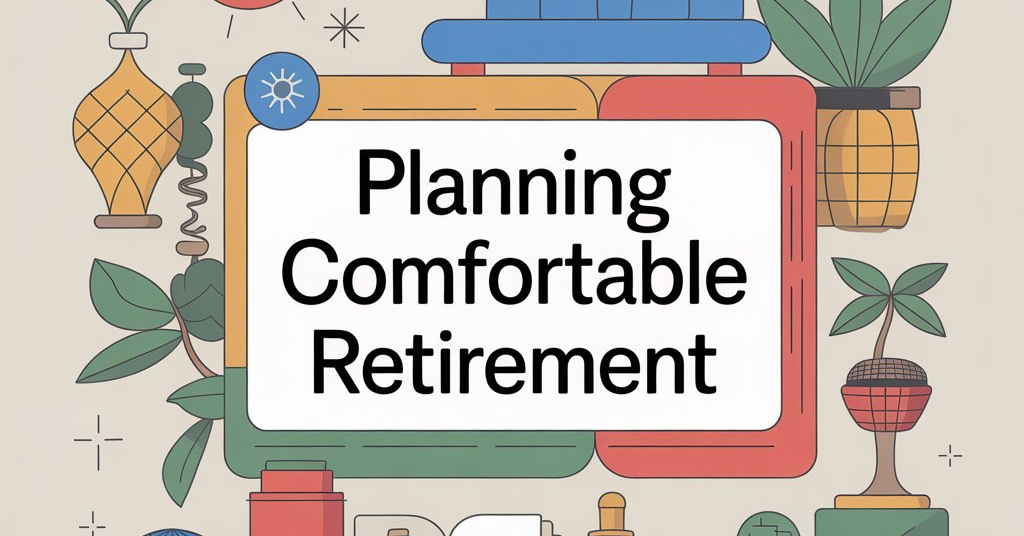Retirement is one of the biggest financial goals in life. It is the stage where you stop working and start enjoying the fruits of your hard work. But the truth is, retirement can be comfortable only if you plan it well. Without proper planning, people face financial stress, depend on others, or even compromise their lifestyle.
In this blog, we will cover everything about planning comfortable retirement—from estimating expenses, calculating retirement corpus, choosing savings strategies, and planning withdrawals, to handling risks. We will also include examples and calculations to make each point clear.
Why Retirement Planning Matters
Before diving into calculations, let’s understand why planning is essential:
- Longevity risk: People today live longer, which means you need money for 20–30 years after retirement.
- Inflation: Prices of food, energy, housing, and medical care rise over time.
- Healthcare: Medical expenses and long-term care costs can eat up a big portion of savings.
- Lifestyle goals: Travel, hobbies, family support, or luxury living require extra funds.
- Financial independence: Planning helps you avoid being dependent on children or relatives.
Step-By-Step: Planning Comfortable Retirement
Step 1: Estimate Your Retirement Expenses
The first step is to know how much you will need every year after retirement.
- Basic expenses: food, utilities, housing, transport.
- Healthcare: regular check-ups, insurance premiums, medicines.
- Lifestyle: travel, hobbies, celebrations.
- Unexpected costs: emergencies, home repairs.
👉 A thumb rule says you will need about 70–80% of your pre-retirement income to live comfortably. But if you plan for travel and luxuries, you may need closer to 100%.
Step 2: Adjust for Inflation
The cost of living today will not remain the same in the future. Inflation makes everything more expensive.
Formula:
Future Cost = Present Cost × (1 + Inflation Rate) ^ Years
Example:
Suppose your current annual expenses = $50,000.
You are 35 today and plan to retire at 65 (30 years later).
Inflation rate = 3%.
Future Expenses = 50,000 × (1.03)^30
= 50,000 × 2.427
= $121,350 per year (in first year of retirement).
This shows why adjusting for inflation is critical.
Step 3: Calculate Retirement Corpus
Your retirement corpus is the total amount you need at retirement to generate enough annual income.
A simple method is the 4% Rule. It says you can safely withdraw 4% of your savings in the first year of retirement and adjust later for inflation.
Formula:
Corpus = First Year Expenses ÷ 0.04
Example (continuing above):
Corpus = 121,350 ÷ 0.04 = $3,033,750
So, you need around $3.03 million saved by age 65.
Step 4: How Much Should You Save Every Year?
Now the big question—how much to save yearly to reach the target corpus.
We use the Future Value of an Annuity formula:
FV = P × [ ( (1 + r)^n − 1 ) ÷ r ]
Where:
- FV = Future Value (target corpus)
- P = Annual Savings
- r = Return Rate (investment return)
- n = Number of Years
Example 1: Early Saver
- Age: 35
- Target Corpus: $3,033,750
- Time to save: 30 years
- Return rate: 6%
P = 3,033,750 × 0.06 / ((1.06)^30 − 1)
= 182,025 / 4.743
= $38,378 per year
👉 If you start at 35, you need to save $38,400 per year.
Example 2: Late Starter
- Age: 50
- Time to save: 15 years
- Target Corpus: $3,033,750
- Return rate: 6%
P = 3,033,750 × 0.06 / ((1.06)^15 − 1)
= 182,025 / 1.396
= $130,400 per year
👉 If you start at 50, you need $130,400 per year.
💡 Lesson: The earlier you start, the less you need to save every year.
Step 5: Choose the Right Investment Strategy
Your investment plan depends on your age:
- Young (20s–30s): Can take higher risk, invest more in equities and growth assets.
- Mid-age (40s–50s): Balanced approach with mix of equity and bonds.
- Near retirement (55+): Focus on safety, capital preservation, fixed income.
Asset Allocation Example
| Age Group | Equity | Bonds/Fixed Income | Cash/Other |
| 25–35 | 70% | 25% | 5% |
| 35–50 | 60% | 35% | 5% |
| 50–60 | 40% | 55% | 5% |
| 60+ | 20% | 70% | 10% |
Diversify your investments into:
- Retirement accounts (401k, IRA, PF, NPS etc.)
- Mutual funds, index funds
- Bonds, fixed deposits
- Real estate / rental income
- Emergency savings
Step 6: Plan Your Withdrawal Strategy
Even after you retire, managing money wisely is crucial.
Common Strategies
- 4% Rule: Withdraw 4% in year 1, adjust with inflation.
- Dynamic Withdrawals: Spend more in good market years, cut back in bad ones.
- Bucket Strategy:
- Short-term bucket (cash, liquid funds) for 2–3 years of expenses.
- Medium-term bucket (bonds) for 5–7 years.
- Long-term bucket (equity) for growth.
- Short-term bucket (cash, liquid funds) for 2–3 years of expenses.
This ensures you don’t run out of money too soon.
Step 7: Healthcare & Long-Term Care
Healthcare is often the biggest retirement expense.
- Buy health insurance early.
- Consider long-term care insurance.
- Keep a separate medical fund.
- Stay healthy through lifestyle changes (exercise, diet).
Step 8: Risk Management
Risks that can disturb retirement:
- Market Risk: Stock markets fall; diversify investments.
- Inflation Risk: Inflation eats value; keep some equity exposure.
- Longevity Risk: Living longer than expected; plan till age 90–95.
- Health Risk: Unexpected medical costs; keep insurance and funds.
- Tax Risk: Understand how pensions and withdrawals are taxed.
Step 9: Estate & Legal Planning
To ensure peace of mind:
- Prepare a will.
- Appoint power of attorney for health and finance.
- Create an advance directive for medical wishes.
- Keep all documents, passwords, and account details in one safe place.
Step 10: Review & Adjust
Your retirement plan should not be static. Review it:
- Every 2–3 years.
- When life changes (marriage, kids, job change).
- When markets shift heavily.
Adjust savings, investments, and spending as needed.
Also Read: Maximise Retirement Savings Superannuation Strategies for Australians
India-Specific Example (₹ Calculation)
Let’s take an Indian case for better clarity:
- Age: 45
- Retirement age: 60 (15 years left)
- Current expenses: ₹10,00,000/year
- Inflation: 6%
- Return rate: 8% before retirement, 5% after retirement
- Life expectancy: 85 (25 years retired)
Step 1: Future expenses at 60 = 10,00,000 × (1.06)^15 = ₹23,96,000/year
Step 2: Corpus needed = 23,96,000 ÷ 0.05 = ₹4.79 crore
Step 3: Annual savings needed:
FV = 4.79 crore, n = 15, r = 0.08
P ≈ ₹17.65 lakh/year = ₹1.47 lakh/month
👉 This shows the power of starting early.
Tips for a Comfortable Retirement
- Start saving in your 20s or 30s.
- Avoid lifestyle inflation.
- Diversify investments across asset classes.
- Minimize investment fees.
- Have an emergency fund separate from retirement savings.
- Stay healthy to reduce medical costs.
- Downsize or relocate to reduce housing costs.
- Continue light part-time work if possible—it keeps you active and adds income.
Common Mistakes to Avoid
- Starting late.
- Ignoring inflation.
- Relying only on one income source.
- Not planning for healthcare.
- Overspending in early retirement.
- Not updating your will and financial documents.
Conclusion
Planning a comfortable retirement is not just about money—it is about peace of mind, independence, and enjoying the next chapter of life. The earlier you start, the easier it becomes. Calculate your future expenses, plan for inflation, build your retirement corpus, invest wisely, and protect yourself from risks.
Remember, retirement should be a time of joy, not financial stress. With careful planning, discipline, and smart investing, you can create a future where you are truly self-reliant and comfortable.



